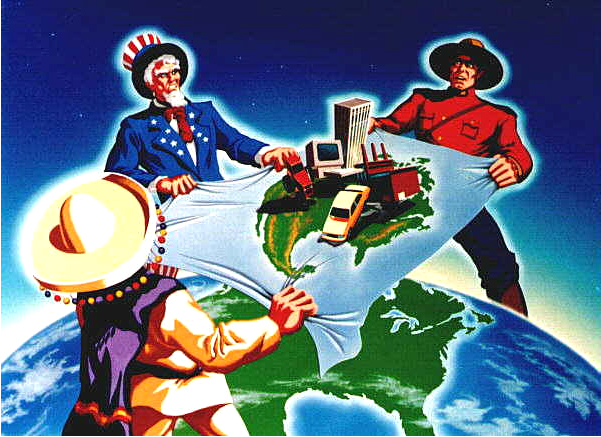NAFTA: Strength Through Economic Unity
President Trump is pushing to end NAFTA despite its economic benefit to the U.S.
Oct 5, 2018
President Donald Trump wants to get rid of NAFTA, the North American Free Trade Agreement that allows for the free flow of goods between Mexico, Canada and the United States.
Signed into law by former President Bill Clinton, NAFTA was drafted on Jan. 1, 1994. The agreement was intended for companies and businesses to trade and negotiate freely across North America. This would effectively eliminate tariffs and create a free trade zone between the three countries.
But Trump doesn’t like that.
Since the beginning of his presidential campaign, Trump has vowed to either fix or terminate NAFTA, and he recently requested renegotiations of the agreement. The president believes that NAFTA is to blame for the loss of US manufacturing jobs because it allows businesses to move their operations to Mexico, where labor costs are much cheaper. Trump insists that these businesses stay; otherwise, they would pay a high price if they wish to leave the states.
UVA economics professor John McLaren and graduate Sushanik Hakobyan studied the effects of NAFTA. They discovered that the agreement heavily lowers the income of blue-collar workers, who also make up a large sum of Trump’s base. But NAFTA significantly affects younger adults in service industries, where wages have stagnated rapidly due to the industries’ dependence on tariff protections. These people coincidentally are not part of the president’s base.
Since 1994, North American trade has increased dramatically. Economists largely agree that the benefits of NAFTA far outweigh the downsides. It allows North American businesses in the three countries to operate freely and trade with one another, stimulating growth and providing equal access to markets. Ultimately, more economic power is given to North America.
Despite the loss of around 682,900 U.S. manufacturing jobs, NAFTA also produced a net gain of five million jobs. Additionally, average wages across the board have increased.
With the elimination of tariffs, the U.S. has access to different oil buyers as well. For example, U.S. oil companies import more of their resources from Mexico because of their inexpensive costs. As a result, our reliance on oil from the Middle East has been reduced, lowering the costs of gasoline. This benefits us with cheaper plane and automobile travel costs.
Canada is the United States’ biggest trading partner, and maintaining free trade between the two states is essential for a continued increase in investment opportunities and economic partnership.
NAFTA helps the U.S. government conserve money as well. All government contracts are accessible to suppliers in all three countries, which increases competition and lowers costs. The increase in American finance and healthcare exports puts Mexican companies out of business. Direct foreign investments have increased and the competitive bidding on contracts have stimulated economic growth. This plants an American economic influence in developing countries.
After the financial crisis in 2008, NAFTA helped the three countries recover by stimulating economic activity and creating jobs. Without it, many millions would be to face unemployment a decade later.
Why would we want to get rid of something that has made us so much stronger?
If President Trump gets his way and abolishes NAFTA, the United States will ultimately suffer irreparable economic harm.
Without NAFTA, Mexico, Canada and the U.S. would not stand a chance against the economic might of China or the European Union—which have their eyes on taking the US’ spot as largest economy.
A stronger North American economy is a stronger American economy.








